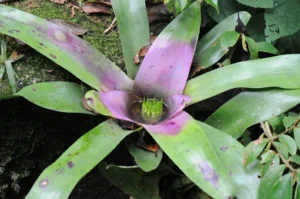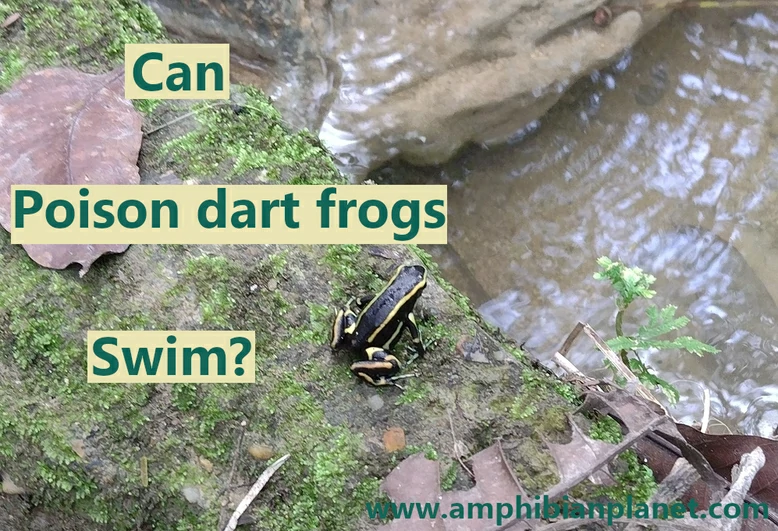Many frogs being their lives as aquatic tadpoles. Even after they transform into adults, they love to hang around ponds and other water bodies where they can swim, hydrate, and keep their skins moist. Poison dart frogs are a type of frog, so you may be wondering if they too can swim.
Generally, poison dart frogs can swim but are not very good swimmers. Unlike aquatic frogs, dart frogs lack webbing between their toes. Instead, each of their toes has a flattened tip, and a suction cup pad to help them grip onto vegetation. They are usually found near water but spend very little time there.
Poison dart frogs are either terrestrial or semi-arboreal – depending on the species. As such, their physical traits are significantly different from those of aquatic frogs.
Poison Dart Frog Tadpoles Are Strong Swimmers
Like most frogs, poison dart frogs hatch from eggs, and start their lives as fully aquatic tadpoles. Tadpoles are very different from adult dart frogs.
This is because they are highly adapted for their aquatic life. They have external gills, to help them breathe in the water – and also have a flat fin-like tail to help them swim.

They swim by flapping their tail from side to side and are excellent swimmers.
Tadpoles Turn Into Juvenile Poison Dart Frogs
After a few months, the tadpoles will go through a process known as metamorphosis, in which they will transform into juvenile frogs.
During metamorphosis, the thyroid gland secretes a growth hormone called thyroxine.
This hormone triggers the tadpoles to:
- Lose the gills, and develop lungs for breathing air
- Absorb the tail into the body
- Grow strong legs for moving on land
- Remodel other organs to form an adult frog
Once this process is complete, tiny froglets (miniature versions of adult frogs), will leave the water, and go on to live a terrestrial, or semi-arboreal life.
These froglets will grow into adult poison dart frogs, and when they are sexually mature – they will lay eggs and transport their tadpoles to individual pools of water.
Adult Poison Dart Frogs Are Not Very Strong Swimmers
Adult dart frogs spend most of their time in humid environments on land and very rarely go into the water. For this reason, their features are highly suited for a life on land, rather than in the water – so they are not very strong swimmers.
However, they are still fairly decent swimmers, and can easily swim around and get out of a pond or another water body – if they happen to fall in.

Why Adult Poison Dart Frogs Are Not Strong Swimmers
Poison dart frogs have small, light bodies. They also have long toes to help wrap around small branches and cling to vegetation.
Their toes have large, round toe pads that work like suction cups to help them cling to wet leaves and other smooth surfaces. These “sticky toes” mean dart frogs can even cling to glass, sometimes completely upside down!
As efficient as these features are for a terrestrial lifestyle, they are not very good for swimming.
Aquatic frogs generally have fully webbed footing and strong powerful hind legs for propelling the frog when in the water.
Since poison dart frogs lack these features, they are not strong swimmers.
How Do Poison Dart Frogs Stay Hydrated?
Frogs have thin, highly permeable skin. They do not drink water through their mouths as we do – instead, they absorb all the moisture they need through their skin.
Most poison dart frogs inhabit humid, primary rainforests, and hydrate by absorbing moisture from the air, and from small water pockets and droplets on leaves, and other surfaces.
They are not dependent on direct access to water like aquatic frogs and generally do not swim or soak in deep water.
How Do Poison Dart Frogs Swim?
Like all frogs, tree frogs swim by pushing water backward with their hind legs.
The legs are usually kicked back simultaneously, but they can sometimes move independently, particularly during slow swimming.
Here is a video of a poison dart frog swimming:
Can Poison Dart Frogs Drown?
Like most frogs and other terrestrial animals, poison dart frogs can drown.
They have lungs, that they use to breathe air (in addition to breathing through their skin), and if their lungs fill up with water, these frogs can drown.
If a poison dart frog gets into a deep water body, and tires out before it can swim out of the water, it can drown.
Do Poison Dart Frogs Lay Eggs in Water?
Unlike most frog species, poison dart frogs do not lay their eggs in the water. Rather, they lay their eggs in moist, protected environments on land.
This could be in leaf litter, logs, palm leaves, bromeliad plants, and even in small animal burrows – as long as they are sheltered and not exposed to the rain.
Once the female lays her clutch of eggs, the male will fertilize them and take care of them until they hatch. He will provide protection and keep the eggs moist.
Sometimes, he may turn the eggs over to make sure the developing embryos receive enough oxygen.
When the eggs hatch, the tadpoles will wriggle onto the male’s back, and he carries them to individual pools of water where they finish development.
This is typically in small pools of rainwater collected in tree holes, or bromeliads.

Once in the water, the tadpoles will swim around and eat algae and detritus, such as dead insects that fall into the water.
In some species, such as the strawberry poison dart frog (Oophaga pumilio), the females will also take care of the tadpoles by unfertilized eggs for them to eat until they turn into froglets.
This is called “oophagy” and is one of the adaptations that many amphibians have developed to survive in harsh environments.
Common Questions
Can Poison Dart Frogs Go in the Water? Poison dart frogs can go in the water, and do so to deposit their tadpoles into small pools of rainwater collected in bromeliads. However, they will generally not go into the water outside of the breeding season, preferring to instead spend most of their time on land.
Are Poison Dart Frogs Good Swimmers? Generally, poison dart frogs are very decent swimmers. However, they lack webbing between their toes, so they are not as strong of swimmers as aquatic frogs with fully webbed feet – and powerful hind legs for propelling them in the water.
Do Blue Poison Dart Frogs Like to Swim? Like all poison dart frogs, blue poison dart frogs can swim; however, they lack webbing between their toes and are not the strongest of swimmers. They do not spend much of their time in the water.
Conclusion
Poison dart frogs start their lives as fully aquatic tadpoles; in this stage, they have gills, flat-paddle-like tails, and are very strong swimmers.
Over time, the tadpoles will grow and go through metamorphosis and transform into froglets that live entirely on land. These froglets will grow into adult tree frogs that live a terrestrial, or semi-arboreal life, depending on the species.
Adult poison dart frogs can swim, but they are not strong swimmers because their anatomy is better suited for their terrestrial lifestyle than it is for swimming.


